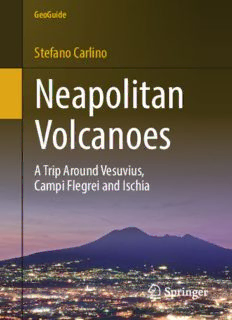Table Of ContentGeoGuide
Stefano Carlino
Neapolitan
Volcanoes
A Trip Around Vesuvius,
Campi Flegrei and Ischia
GeoGuide
Series editors
Wolfgang Eder, Germany
Peter T. Bobrowsky, Canada
Jesús Martínez-Frías, Spain
Axel Vollbrecht, Germany
The GeoGuide series publishes travel guide type short monographs focussed on
areas and regions of geo-morphological and geological importance including Ge-
oparks,NationalParks,WorldHeritageareasandGeosites.Volumesinthisseries
areproducedwiththefocusonpublicoutreachandprovideanintroductiontothe
geological and environmental context of the region followed by in depth and
colourfuldescriptionsofeachGeositeanditssignificance.Eachvolumeissupple-
mentedwithecological,culturalandlogisticaltipsandinformationtoallowthese
beautifulandfascinatingregionsoftheworldtobefullyenjoyed.
More information about this series at http://www.springer.com/series/11638
Stefano Carlino
Neapolitan Volcanoes
A Trip Around Vesuvius, Campi
Flegrei and Ischia
123
StefanoCarlino
Istituto Nazionale di Geofisica e
Vulcanologia
Sezione diNapoli, Osservatorio Vesuviano
Naples
Italy
ISSN 2364-6497 ISSN 2364-6500 (electronic)
GeoGuide
ISBN978-3-319-92876-0 ISBN978-3-319-92877-7 (eBook)
https://doi.org/10.1007/978-3-319-92877-7
LibraryofCongressControlNumber:2018943722
©SpringerInternationalPublishingAG,partofSpringerNature2019
Thisworkissubjecttocopyright.AllrightsarereservedbythePublisher,whetherthewholeor
part of the material is concerned, specifically the rights of translation, reprinting, reuse of
illustrations,recitation,broadcasting,reproductiononmicrofilmsorinanyotherphysicalway,and
transmissionorinformationstorageandretrieval,electronicadaptation,computersoftware,orby
similarordissimilarmethodologynowknownorhereafterdeveloped.
The use of general descriptive names, registered names, trademarks, service marks, etc. in this
publicationdoesnotimply,evenintheabsenceofaspecificstatement,thatsuchnamesareexempt
fromtherelevantprotectivelawsandregulationsandthereforefreeforgeneraluse.
Thepublisher,theauthorsandtheeditorsaresafetoassumethattheadviceandinformationinthis
bookarebelievedtobetrueandaccurateatthedateofpublication.Neitherthepublishernorthe
authorsortheeditorsgiveawarranty,expressorimplied,withrespecttothematerialcontained
hereinorforanyerrorsoromissionsthatmayhavebeenmade.Thepublisherremainsneutralwith
regardtojurisdictionalclaimsinpublishedmapsandinstitutionalaffiliations.
Printedonacid-freepaper
ThisSpringerimprintispublishedbytheregisteredcompanySpringerInternationalPublishingAG
partofSpringerNature
Theregisteredcompanyaddressis:Gewerbestrasse11,6330Cham,Switzerland
The Somma-Vesuvius volcanic complex (courtesy G. Vilardo, Geomatic Laboratory of
OV-INGV)
TheCampiFlegreicaldera(courtesyG.Vilardo,GeomaticLaboratoryofOV-INGV)
TheIslandofIschia(courtesyG.Vilardo,GeomaticLaboratoryofOV-INGV)
Foreword
NeapolitanVolcanoesismorethanaguidetotheworld’smostexcitingvolcanoes:
it is a story of how volcanology has grown from an entertainment for Europe’s
curiousnobilitytooneofthemostfascinatingandchallengingbranchesofmodern
Earth Sciences. It is a story, too, of how people have lived and flourished among
the most resplendent and dangerous forces of Nature.
Vesuvius,CampiFlegreiandIschia:thenamesaloneevoketalesofthegrowth
of European culture from Ancient Greece and Rome to the Grand Tour of the
aristocracy in the eighteenth and nineteenth centuries. Even more, the conse-
quencesoferuptionscanbetracedbackatleast40millennia,whentheeruptionof
theCampanianIgnimbrite,fromwithinornearCampiFlegrei,heraldedthedemise
of Neanderthals in Europe.
From a volcanological perspective, outbursts from Vesuvius in particular have
providedthetemplateforunderstandingcommonstylesoferuptionobservedaround
theworld.Mostfamousisthefirstwrittenaccountofthestyleofexplosiveeruption
thatoverwhelmedPompeiiandHerculaneumin79A.D.,nowdescribedasPlinianin
honourofbothPlinytheYounger,whowrotethedescription,andhisunclePlinythe
Elderwho,asadmiraloftheRomanfleet,setsailfromMisenointheCampiFlegrei
and died offering succour to those fleeing from the eruption. At the other extreme,
sixteencenturieslatertheriversofmoltenrockthatoozedfromthevolcanoacquired
the name of lava, from the Italian verb lavare, to suggest that the slopes of the
volcanohad beenwashed clean.
WatchingthevolcanoesaroundNaplesalsorevealstheimportanceoflearning
from experience. Between 1764 and 1800, William Hamilton—self-taught volca-
nologist and British plenipotentiary to the court in Naples—regularly hosted vis-
itors to Vesuvius and Campi Flegrei. Writing to the Royal Society of London in
1779,hecommentedthathehadbeentothesummitofVesuvius58timesandhad
visited thelowerslopes ofthevolcano at leastfourtimes moreoften. Evenso he
says“IamnotashamedtoownthatIcomprehendverylittleofthewondersIhave
ix
x Foreword
seen on this great laboratory of Nature”, adding that “yet there have been natu-
ralists, of such a wonderful penetrating genius, as to have thought themselves
sufficiently qualified to account for every phenomenon of Vesuvius, after having,
literally speaking, given the volcano a coup d’oeil”. The record shows that
Hamilton’sunderstandingfarexceededthatofhisguestswithpenetrating genius.
Neapolitan Volcanoesfollow Hamilton’sprinciple andunderline howwe arestill
learning 250 years later.
The volcanoes today support a population of about one million people, not
counting Naples,whose urban sprawloverlaps the CampiFlegrei to the westand
reachesthefoothillsofVesuviustotheeast. Vesuviushasbeenquietsince 1944,
Campi Flegrei since 1538 and Ischia since 1302. No one has a memory of how
theirlocalvolcanoesbehave.Thisbookshowsthedebtmodernvolcanologyowes
tounderstandingNeapolitanVolcanoesandhowsuchunderstandingisessentialto
preparing for when the very same volcanoes will come back to life.
London, UK Christopher Kilburn
UCL Hazard Centre, University College London
Description:This book serves as a guide to discovering the most interesting volcano sites in Italy. Accompanied by some extraordinary contemporary images of active Neapolitan volcanoes, it explains the main volcanic processes that have been shaping the landscape of the Campania region and influencing human sett

